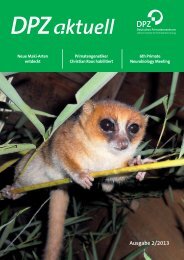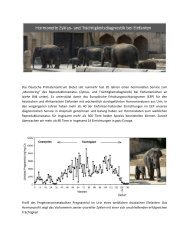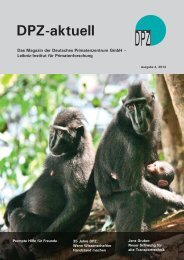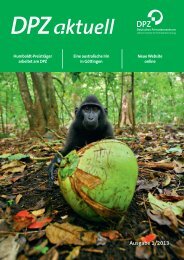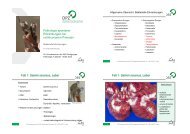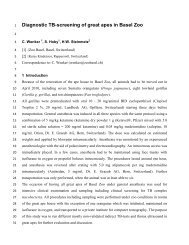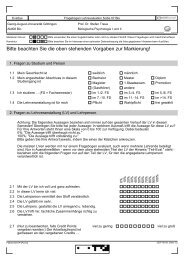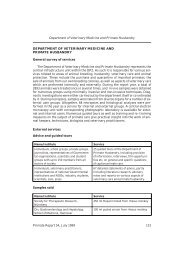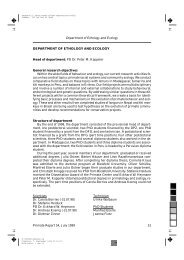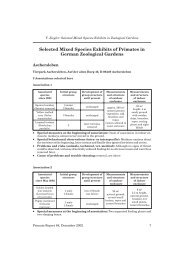Vol. 15 - Deutsches Primatenzentrum
Vol. 15 - Deutsches Primatenzentrum
Vol. 15 - Deutsches Primatenzentrum
You also want an ePaper? Increase the reach of your titles
YUMPU automatically turns print PDFs into web optimized ePapers that Google loves.
Lemur News <strong>Vol</strong>. <strong>15</strong>, 2010 Page 29<br />
females may be more interested in food during the breeding<br />
season than the males which,in turn,may be more interested<br />
in the females (Roullet, 1998).<br />
The enrichment made with a branch covered in fruit juice<br />
was the most used by the animals:This is a branch (diameter<br />
of around 5 cm, length of 30-40 cm) in which two trenches<br />
are dug along its length. The branch is fixed onto the mesh<br />
roof. We apply the fruit juice in the trenches with a brush<br />
(Roullet,1998).The animals spend their time licking the juice<br />
out of the branch as they would do with sap in wild (Martin,<br />
1973).<br />
Mixed-species exhibits<br />
Paris Zoo experienced 2 successful combinations:with ayesayes<br />
(Daubentonia madagascariensis) and greater tenrecs<br />
(Tenrec ecaudatus).We tried to put the mouse lemurs in with<br />
slow lorises (Nycticebus coucang), but without success:<br />
wounds were observed on the mouse lemurs’ tails, so they<br />
were removed from the exhibit.<br />
References<br />
Martin, R.D. 1973. A review of the behaviour and ecology of<br />
the lesser mouse lemur (Microcebus murinus). Pp. 1-68. In:<br />
R.P. Michael; J.H. Crook (eds.). Comparative ecology and<br />
behaviour of primates. Academic Press, London, UK.<br />
Pes, T. 2009. The European Studbook of Grey Mouse Lemur<br />
(Microcebus murinus). Zoo and Botanical Garden Plzen.<br />
Roullet, D. 1998. Effet d’un enrichissement physique sur les<br />
comportements agonistiques et exploratoires de plusieurs<br />
groupes de microcèbes murins (Microcebus murinus)<br />
en captivité. DESS d’Ethologie Appliquée et de Chronobiologie<br />
du Comportement. Université Paris XI.<br />
Articles<br />
Diurnal lemur density in the national<br />
park parcel Ivontaka Nord, UNESCO<br />
Biosphere Reserve of Mananara-Nord<br />
Marta Polasky Lyons<br />
School for International Training, Fort Dauphin, Madagascar;<br />
and Carleton College, Northfield, Minnesota, USA,<br />
marta.lyons@gmail.com<br />
Abstract<br />
Here I present a recent diurnal lemur density study performed<br />
in the Biosphere Reserve of Mananara Nord, conducted<br />
between the dates of November 9 and 22, 2008 in<br />
Ivontaka Nord; part of Mananara-Nord National Park. Densities<br />
were calculated using transect walks, and other information<br />
was gathered through interviews with local people<br />
and national park staff. The density of Eulemur fulvus albifrons<br />
appears to be over twice that recorded in other areas<br />
(Table 1), while the density of Varecia variegata variegata<br />
appears to be low,perhaps due to the latter’s preference for<br />
undisturbed habitat and past problems with overhunting. In<br />
addition, Eulemur rubriventer was found to inhabit the park,<br />
though its range was previously thought not to extend east<br />
into the biosphere. Having been, in the past, under strong<br />
pressures from local inhabitants,Ivontaka Nord represents a<br />
disturbed low altitude rainforest;however this report shows<br />
that the lemur populations within the parcel may be recovering.<br />
Introduction<br />
Background<br />
The Biosphere Reserve of Mananara-Nord was created in<br />
1989. It is one of 533 UNESCO (the United Nations Educational,<br />
Scientific, and Cultural Organization) Biospheres<br />
around the world.The Biosphere Reserve of Mananara Nord<br />
covers 144,000 ha,with 23,000 ha being devoted to a terrestrial<br />
park,and another 1,000 ha to a marine park.The terrestrial<br />
national park is split into three separate parcels. Going<br />
from north to south these parcels are: Ivontaka Nord,<br />
Ivontaka Sud, and Verezanantsoro. The parcel of Ivontaka<br />
Nord covers an area of only 827 ha.This is small compared to<br />
the other two parcels; Ivontaka Sud and Verezanantsoro,<br />
which are 1,300 ha and 20,685 ha respectively (Fig. 1). These<br />
parcels are connected by forest sections that are not protected<br />
by the national park system (ANGAP, 2005).<br />
Fig.1:National Park of Mananara-Nord.Three parcels in dark<br />
shade,going from north to south:Ivontaka Nord (where this<br />
survey was carried out), Ivontaka Sud, Verezanantsoro.<br />
Source: MNP.<br />
Threats<br />
It is estimated that approximately 1.9 to 2.2 % of the primary<br />
forest within the biosphere is cleared every year, usually for<br />
rice cultivation through tavy (slash and burn agriculture)<br />
(ANGAP, 2005). Besides just destroying necessary habitat,<br />
this deforestation further splits already extremely fragmented<br />
sections of primary forest.Another concern is illegal<br />
(and legal) selective extraction. The population within the<br />
biosphere relies on wood for constructing their houses and<br />
fuel for cooking.In the villages most cooking is done over an<br />
open flame using collected wood.The wood does not simply<br />
go to the villages on the periphery of a forest,but is also collected<br />
for sale in urban centers and areas farther away from<br />
the forest.





